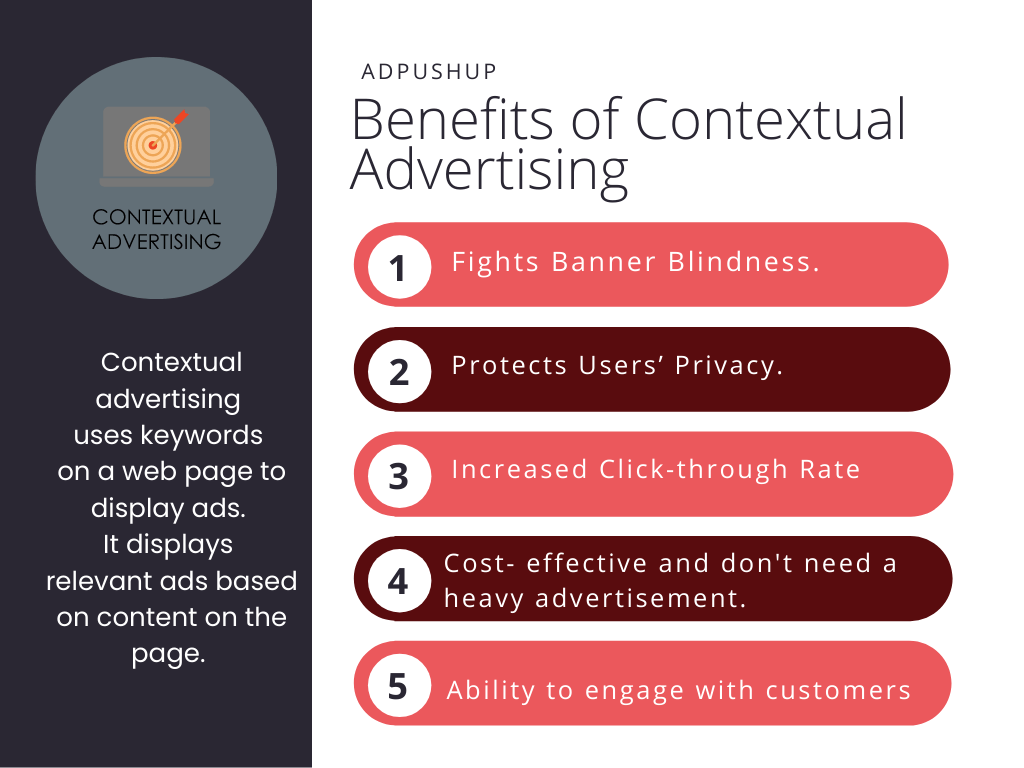If you’re looking to improve your website’s performance and ROI, contextual advertising can help! Here’s how it works and how you can get started.
Have you ever encountered an advertisement on a website that is so pertinent to what you’re interested in that you find yourself exclaiming, “Wow, that’s exactly what I was looking for!” If such is the case, contextual advertising is the one to be credited. Lately, there’s a lot of buzz surrounding contextual advertising, and it makes sense considering how creatively it helps advertisers tap into that coveted customers’ attention span.
Thus, many advertisers are employing contextual advertising to scale their business.
In fact, research conducted by MarketsandMarkets has found out contextual advertising is likely to reach USD 297.68 by 2023.
According to a study conducted by GumGum, contextually relevant ads generated 43% more neural engagement. In fact, users recalled contextual ads 2.2x better than other ads. This year, with its impending third-party cookie apocalypse and impact on programmatic revenue, has made publishers shift their focus to contextual targeting.
But, what is contextual targeting?
In this post, we have tried helping publishers understand “what is contextual advertising”, its benefits, and how it works.

What is Contextual Advertising?
So, what does contextual advertising mean? Contextual advertising is the technique of displaying adverts on websites based on the content of those pages. In simpler words, it is all about targeting your audience at the right time and on the right platform.
The process is called contextual targeting, which includes engaging the audience, learning about their interest, and providing them with pertinent information.
Now let’s get back to “what is contextual advertising”. For example, a page that emphasizes skincare products will utilize the algorithms underlying a contextual advertising solution to add relevant ads. These ads are tailored to the page’s context, whether it be a video, article, or online merchant selling them.
An illustration of contextual advertising can be displaying a sunscreen advertisement in a blog article instructing readers about the skincare regimen. This is accomplished by segmenting advertising based on certain criteria like keywords and website subjects using contextual targeting on an ad network.
How Contextual Advertising Works?
Well, you must be wondering – what is contextual targeting in advertising? Contextual advertising uses keywords on a web page to display ads. Unlike behavioral targeting, where tracking pixels and cookies are used, contextual targeting displays relevant ads based on content on the page.
This has a positive impact on users browsing the web page. The ads remain contextually relevant, thus getting better viewability. Thus, more and more business owners are enlisting the services of contextual advertising companies to promote their products/services better.
According to the research executed by Kenneth Research, 69% of consumers engage more with contextually relevant content, especially ads.
Here’s another example to understand contextual advertising better. The screenshot below shows a Wall Street Journal web page with the primary story of rising fuel demand.
The ads on the sidebar is for Winergy Gearboxes, a renewable energy product. Thus, this contextually relevant ad makes much sense next to content related to depleting natural resources.

Contextual ads are based on the surrounding content on the web page you are viewing. For example, if you were to visit a technology-based website, you might see an ad related to gadgets.
Here’s another example of the same. The following post by Verizon promotes a new Samsung phone on the technology publisher TechCrunch.
Image Source – Verizon
Google AdSense and Contextual Advertising
Google AdSense relies on the Google Display Network (GDN) or approved Google-certified ad networks to serve advertisements. It leverages bots to analyze web pages for relevant keywords and content before displaying contextual ads.
In addition to text analysis, Google AdSense leverages images and their associated content to enhance accuracy for ad targeting. When opting for automated advertising, the ad publisher furnishes contextual data such as categories, tags, content, keywords, and URLs to the ad server. Subsequently, this data is relayed to ad networks, exchanges, or Supply Side Platforms (SSPs), which in turn provide it to Demand Side Platforms (DSPs).
The DSPs are ultimately responsible for delivering the contextual ads.
On the contrary, in header bidding, publishers provide contextual information to a wrapper. This wrapper then conveys the information to exchanges or Supply Side Platforms (SSPs) using ad requests. The details are transmitted in the shape of bid requests to pertinent Demand Side Platforms (DSPs).
Contextual Targeting vs. Behavioral Targeting
Publishers often find themselves asking which targeting is better, behavioral or contextual? The answer is neither as both types offer different kinds of advantages.
However, there is a sudden surge in interest for contextual ads, and for good reasons. It is a great alternative to behavioral targeting for surviving third-party cookie deprecation. But without this context, neither type can be deemed superior.
Here are some significant differences between the two:
| Category | Contextual Targeting | Behavioural Targeting |
| Tracking | Makes use of keywords on a web page to display relevant ads | Uses cookies which track online behaviour for displaying ads |
| Data privacy | Effortless privacy compliance as ads use keywords | Requires additional step of obtaining user content |
| Accuracy | Less accurate as users may not be interested in the product at all | More accurate as ads are based on the user’s interests |
| Dependency | Doesn’t depend on user data. Advertisers can easily target users based on webpage info | Entirely depends on user data. If users decline the use of data, advertisers can’t use this option |
| CPM | Works on the ‘best-fit’ principle, hence, advertisers are known to put less money – around 10- to 30- cents range. | Since users are targeted with more accuracy, advertisers are known to put a range between 50 cents to $3. |
| Best case | Works best with audience segmentation and niche webpages | Works for all kinds of webpages and niche |
Top 5 Advantages of Contextual Advertising
Contextual advertising comes with an umpteen number of benefits, here are 5 of them:

1. Fights Banner Blindness
Banner blindness is a common phenomenon in which users have learned to ignore ads subconsciously. However, contextually targeted ads can help fight that simply by their relevance.
For example, a movie review website serving ads for a movie ticket booking website makes more sense than it serving ads related to cars.
In a study by Infolinks conducted on fighting banner blindness, contextually relevant ads of lesser-known brands were recalled 82% more by people as opposed to ads of famous brands but irrelevant to page content.
Ad placement matters. An ad placed next to/between relevant content immediately increases its value and therefore, offers a higher CTR potential.
2. Protects Users’ Privacy
The best part about contextual advertising is that it does not partake in exploiting user data for tracking online behavior. All the ads generated through contextual targeting make use of keywords, helping publishers in building trust among their users.
Contextual targeting helps publishers to comply with privacy laws such as the GDPR, CCPA, and others.
3. Increased Click-through Rate
Contextual advertising benefits all: users, publishers, and brands. It benefits users by introducing them to relevant products through targeted ads. When users view relevant ads, ad viewability piques and there is an increased likelihood of a high click-through rate.
4. Cost-Effective & Don’t Need Heavy Advertisement
Contextual ads are more effective and economically friendly than conventional ads- you only pay for the ads that people click on rather than displayed ads. These ads also come with a specialized message and link to shop.
5. Ability to Engage with the Customers
Lastly, it allows brands to converse and engage with customers. You may interact with them in an instructive and useful way by giving them information that is pertinent to what they are searching for. This increases your company’s visibility and facilitates a stronger connection with potential clients. All thanks to the contextual targeting.
What are Some Disadvantages of Contextual Advertising?
Although there are not many disadvantages to contextual advertising, there are a few potential pitfalls that website owners should be aware of. Contextual ads can be distracting to website visitors, and if they are poorly placed, they can disrupt the flow of content and annoy consumers. This is not a problem that is limited to contextual ads but can occur with any type of website.
How to Run Contextual Targeting in Google Ad Manager?
Publishers who use Google AdSense already utilize the in-built feature of contextual targeting. AdSense uses keywords/ keyphrases on a webpage to find relevant ads for website users.
For publishers using Google Ad Manager, things are slightly different. Contextual targeting in GAM is performed via key-value targeting.
Key values are used in Google Ad Manager to identify or define custom preferences such as specific ad inventory, pages, etc. They are used for all kinds of targeting, including contextual.
Also Read: How to Use Key-value Targeting in Google Ad Manager
How Can Contextual Ads Help Publishers?
Adding Key-Values
- On GAM’s homepage, click on Inventory >> Key-values >> New Key-value.
- Assign a Name and a Display Name.
- Select a Value Type. This has two options: Dynamic and Pre-defined.
- Go to Report on Values and select Yes if you wish to make the keys reportable. Otherwise, set your preferences accordingly.
- Now go to New Values under Targeting Values and add values according to your preferences. One can add as many values as they want.
- Click on Save.
The remaining process requires a thorough understanding of Google Publisher Tags which are used for adding the key-values to an ad request. Through key-values, publishers can perform two kinds of targeting: ad slot-level and page-level.
Ad-slot Level Targeting: Publishers can use the setTargeting() function to assign key-values to individual ad slots. This is recommended for granular targeting for a particular audience.
Page-level Targeting: This is beneficial for a broad-level targeting such as targeting an entire page. This reduces the amount of header code to be added. Publishers should use googletag.pubads().setTargeting to use page-level targeting.
Future of Contextual Advertising
There is no doubt that contextual ads is here to stay. With the advent of new technologies, context ads or contextual advertising is only going to become more sophisticated and targeted. Advertisers will be able to use data to target their ads more effectively, and consumers will be able to see more relevant ads.
In the near future, we can expect contextual ads to eliminate a highly flawed third-party cookie-based models. Instead of relying on user-validated information through machine learning models to determine context.
Conclusion
The ad tech industry is highly volatile, and both the demand and sell-side constantly need to revise their technical requirements. To survive the third-party cookie apocalypse, publishers must rethink their targeting strategies.
Contextual targeting is an effective solution that publishers can embrace. Since most publishers already work with Google-based ad tech, getting started with contextual targeting should be easy.
In the end, publishers need to remember that users are the biggest strength of the digital advertising ecosystem. Keeping users satisfied and in control of their data should be their topmost priority. We hope by now you’ve understood what contextual advertising is.
FREQUENTLY ASKED QUESTIONS
Advertisers employ various forms of data to develop contextually relevant adverts. They may examine information about a person’s location, the time of day they access websites or even the kind of gadget they use. Advertisers can display adverts to users more likely to be of interest to them by analyzing these contextual cues.
A contextual strategy increases the likelihood of conversion, engagement, and time on site which lead to greater ROI. Contextual strategies eliminate the guesswork and human error that comes.
A contextual strategy takes all the information about what the user is doing, who they are, and what they are saying and combines it with the information you have about your business and customers to create the best possible experience.
Contextual advertising can be defined as an ad placement that is relevant to the content of a web page rather than the site’s look and feel. For instance, a site whose content is related to automobiles will serve an auto ad rather than a cosmetics ad on their site. Contextual advertising is a great way to build a brand’s image and drive traffic.
We have also listed a few more examples in the blog above thoroughly. Be sure to take a look.
Contextual targeting is a form of online marketing where a business can target advertisements for certain websites and online content. This is usually based upon the user’s history of visiting websites, the users’ search history and often the content of the website itself.
Additionally, contextual targeting is different from behavioural targeting, where a user’s online activity is recorded and then using this data, the user is shown highly relevant advertising at a later date. Hope you’ve well-versed in the concept of what is contextual targeting.
The future of contextual ads looks very promising. With internet penetration around the globe, and more and more people joining the internet every day, we will see more and more advertising networks focusing on contextual advertisement. It is increasingly becoming the mainstream for online advertising, and this new style of advertising is really taking hold.
Using contextual advertising is an effective way to advertise your company. You are not only reaching your target audience but also reaching them in the context of the information that they may need.
Using context ads allows you to be more specific to your customers and serves the customer ads that are more relevant to them. When a customer sees an ad that directly pertains to their current situation, it is more likely that they will click on the ad, resulting in a higher conversion rate.

Shubham is a digital marketer with rich experience working in the advertisement technology industry. He has vast experience in the programmatic industry, driving business strategy and scaling functions including but not limited to growth and marketing, Operations, process optimization, and Sales.







